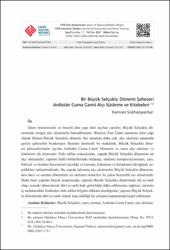Bir Büyük Selçuklu Dönemi Şaheseri Ardistân Cuma Camii Alçı Süsleme ve Kitabeleri
Künye
SOKHANPARDAZ, Kamran. "Bir Büyük Selçuklu Dönemi Şaheseri Ardistân Cuma Camii Alçı Süsleme ve Kitabeleri". FSM İlmi Araştırmalar İnsan ve Toplum Bilimleri Dergisi, 17 (2021): 111-194.Özet
İslam mimarisinde en önemli dini yapı türü sayılan camiler, Büyük Selçuklu döneminde
zengin alçı süslemeler barındırmıştır. Böylece İran İslam sanatının altın çağı
olarak bilinen Büyük Selçuklu dönemi, her sanattan daha çok, alçı süsleme sanatında
geriye şaheserler bırakmıştır. Bundan hareketle bu makalede, Büyük Selçuklu dönemi
şaheserlerinden sayılan Ardistân Cuma Camii Mimarisi ve onun alçı süsleme ve
kitabeleri ele alınmıştır. Elde edilen sonuçlardan, yapıda Büyük Selçuklu dönemine ait
alçı süslemeler, yapının farklı bölümlerinde bulunup, süsleme kompozisyonunun, yazı,
bitkisel ve hendesi bezemeleri içerdiği ve kazıma, kabartma ve kalıplama tekniğinde yapıldıkları
anlaşılmaktadır. Bu yapıda işlenmiş alçı süslemeler Büyük Selçuklu döneminden
önce ve sonraki dönemlere ait süsleme örnekleri ile yakın benzerlik arz etmektedir.
Daha önce yapılan birçok araştırmada, yapının Büyük Selçuklu döneminde tek eyvanlı
olup, sonraki dönemlerde dört eyvanlı hale getirildiği iddia edilmesine rağmen, caminin
iç mekânındaki kitabeden elde edilen bilgiler dikkate alındığında, yapının Büyük Selçuklu
döneminde dört eyvanlı olarak inşa edildiği bu çalışma kapsamında tespit edilmiştir. the mosques are considered to be the most important religious building type in Islamic
architecture. The mosques had rich stucco ornaments during the Great Seljuk period.
From the Great Seljuk period, known as the golden age of Iranian Islamic art, remains
masterpieces in the art of stucco decoration more than any other art kind. In this article,
the architecture of the great mosque of Ardestan, which is considered as one of the
masterpieces of the Great Seljuk Period, and also its stucco ornaments and inscriptions
are discussed. According to the results, the stucco decorations in these mosques include
inscriptions, vegetal and geometric decorations made using embossing, engraving, and
stamping techniques. The stucco ornaments of this mosque are similar to the ornaments
of periods before and after the Great Seljuk era. Although it was claimed in many previous
studies that the building had a single porch during the Great Seljuk period and was
transformed into four porches in the following periods, considering the information obtained
from the inscription in the interior of the mosque, was determined that this mosque
was built in the form of four porches during the Great Seljuk period.



















